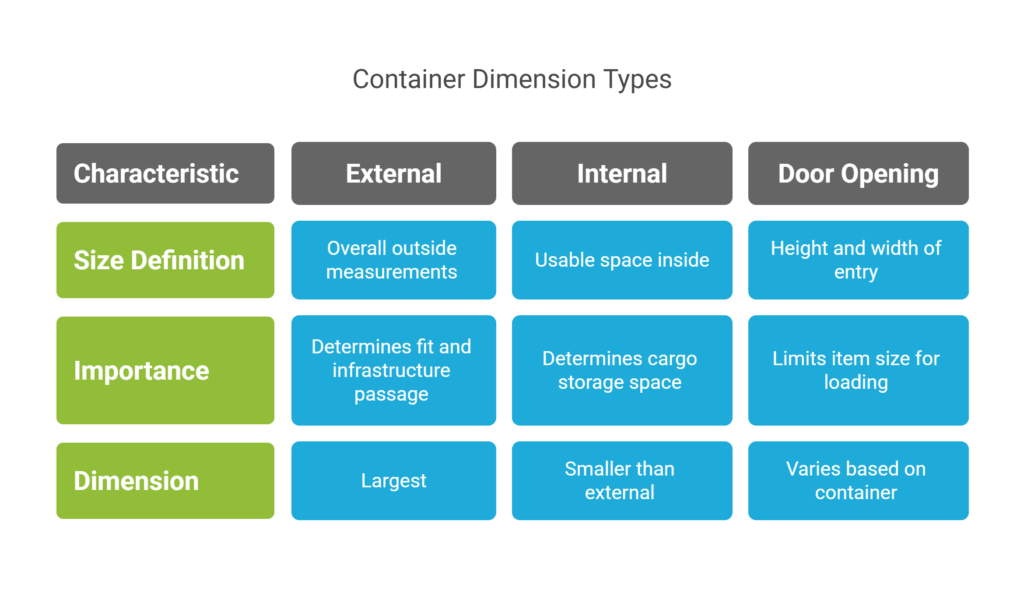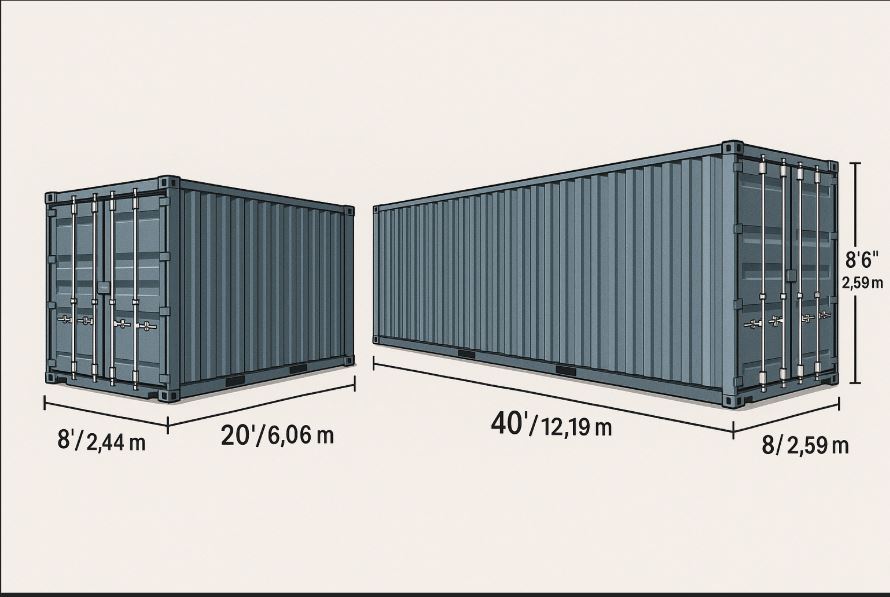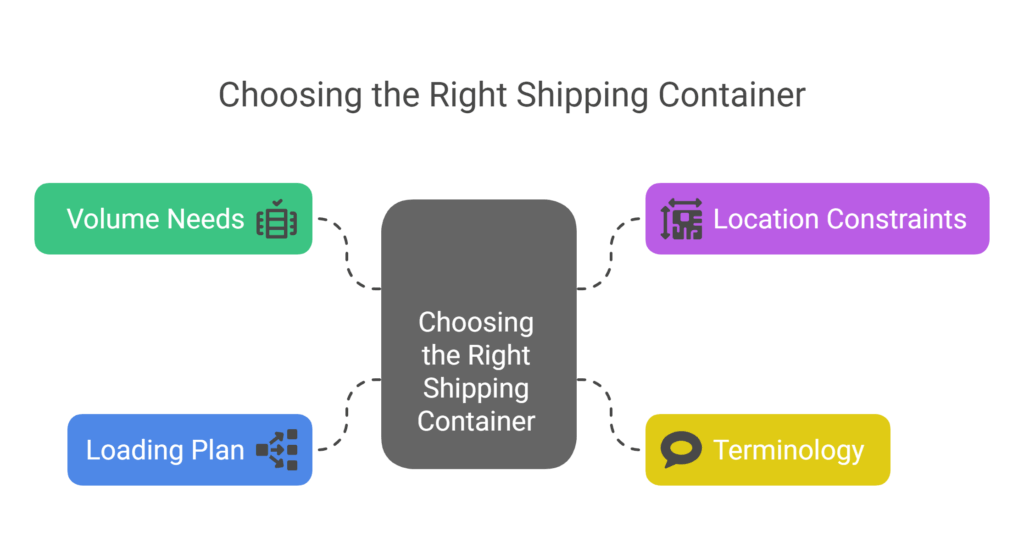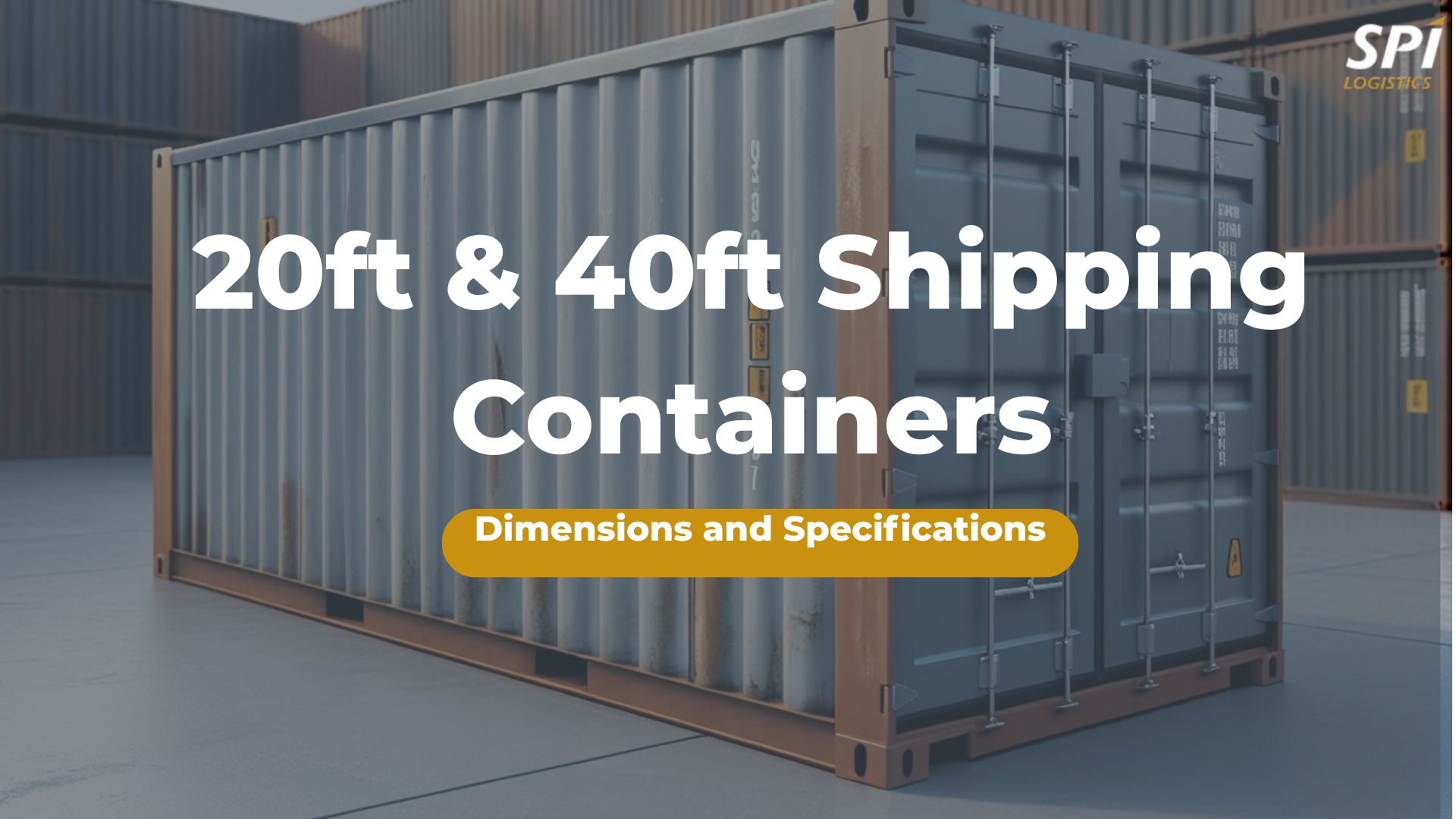Shipping containers are the backbone of global logistics, but when it comes to planning storage, transport, or modification projects, knowing the exact specifications is essential. Whether you’re choosing between a 20ft or 40ft unit, this detailed guide will help you understand container dimensions, specifications, and sizes.
What Is a Container Dimension?
A container dimension refers to the precise external and internal measurements of a shipping container, including length, width, and height. These measurements ensure containers can be stacked, stored, and transported efficiently across ships, trains, and trucks.
Why Container Dimensions Matter
Shipping containers are the backbone of global trade. Knowing exact specifications like 20 ft container dimensions in inches or the 40 ft shipping container dimensions allows you to make informed decisions about load capacity, logistics planning, and compatibility with storage spaces or trailers.
Understanding the precise dimensions and specs of shipping containers allows for:
- Optimized cargo planning
- Accurate modification designs
- Safe stacking and transport
- Cost-effective space utilization
According to the United Nations Conference on Trade and Development (UNCTAD), over 80% of global trade by volume is carried by sea, with shipping containers playing a crucial role in standardizing freight movement (UNCTAD, 2024).
What advantages do shipping containers offer over traditional cargo transport methods in terms of durability, security, and cost-efficiency?
Types of container dimensions
- External Dimensions: These are the overall outside measurements of the container, length, width, and height. External dimensions are crucial because they determine how containers fit together when stacked on ships, trucks, or trains, and whether they can safely pass through infrastructure like bridges and tunnels.
For example, a standard container height of 8 feet 6 inches is designed to comply with most road clearance limits. If the container is taller (like a high cube at 9 feet 6 inches), special permits might be needed for transport.
- Internal Dimensions: These are the usable space inside the container where cargo is actually stored. Internal dimensions are always smaller than external dimensions due to the thickness of the walls and flooring.
For example, a 20ft container’s internal length is about 19.35 feet, not the full 20 feet externally. This difference affects how much cargo you can pack, such as pallets or boxes, so precise measurements are necessary for efficient loading.
- Door Opening Dimensions: This refers to the height and width of the container’s door opening. It’s important because it limits what size items can be loaded or unloaded through the doors.
For instance, if you have large machinery or oversized crates, you need to confirm the door opening is wide and tall enough to accommodate them. A typical 20ft container door opening might be around 7 feet 5 inches wide and 7 feet 6 inches tall.

Standard shipping container dimensions are regulated by ISO standards (ISO 668) to ensure interoperability worldwide. This means containers made by different manufacturers or used in different countries follow the same size guidelines, allowing seamless transport and stacking across global shipping networks.
How do different container types cater to diverse cargo needs?
20ft Shipping Container
The 20 ft shipping container dimensions are standardized globally. When it comes to logistics planning or space allocation, businesses often ask, “How wide is a 20ft shipping container?
Let’s start with the most common unit: the 20ft shipping container.
Standard 20 Foot Shipping Container Dimensions
-
External Dimensions:
- Length: 20 feet (approx. 240 inches)
- Width: 8 feet (96 inches)
- Height: 8 feet 6 inches (102 inches)
-
Internal Dimensions:
- Length: approx. 233 inches
- Width: approx. 92 inches
- Height: approx. 94 inches
“If you are looking for 20 ft container dimensions in inches, these numbers above give you an accurate layout.”
Key 20ft Specs:
- Tare weight: 4,850 lbs
- Max gross weight: 52,900 lbs
- Payload capacity: 47,000 lbs approx.
These specs comply with ISO 668 container standards and are recognized globally for intermodal transport compatibility (Bureau International des Containers, n.d.).
Alternative Specs Mentioned:
- 20 foot shipping container specs match ISO standards.
- Variants may include 20 feet container specification with slightly reduced height for specific rail or sea freight routes.
“If you need to calculate internal volume, don’t forget to check 20ft container dimensions for exact space usage.”
Applications
Shipping containers are incredibly versatile, extending far beyond traditional cargo transport. Their standardized sizes and durable build make them ideal for a variety of applications across industries. Here are some common and innovative ways 20ft containers are put to work:
- Storing building materials
- Construction site offices
- Personal storage
- Modular building conversions
Common Terms
When selecting the right container, it’s crucial to understand key measurements and technical terms. Here’s what you should know about 20ft containers:
- 20 ft shipping container specs: These include capacity, weight limits, clearance height, and build standards.
- 20 ft container height: The standard height is 8 feet 6 inches (102 inches), though high-cube versions are taller.
- 20ft shipping container dimensions: Essential for international freight compatibility and loading efficiency.
- Size of 20ft shipping container: Slight variations exist, but the ISO standard ensures consistency across suppliers.
- 20 feet container specification: This covers the CSC plate standards and ISO certification needed for international shipping.
- 20ft container length: While the external length is 20 feet (240 inches), the internal length is about 19.35 feet (233 inches).
Understanding these keywords not only helps with purchasing or leasing the right unit but also ensures compliance with regulations and compatibility with transport infrastructure.
“The 20ft container remains a favorite for businesses balancing space and cost-efficiency.”
Looking for reliable back-office support to streamline your freight brokerage operations with 20ft containers? Explore our specialized Freight Brokerage Back Office Support services here.
40ft Shipping Container
Standard 40 Foot Shipping Container Dimensions
-
External Dimensions:
- Length: 40 feet (480 inches)
- Width: 8 feet (96 inches)
- Height: 8 feet 6 inches (102 inches)
-
Internal Dimensions:
- Length: approx. 472 inches
- Width: approx. 92 inches
- Height: approx. 94 inches
Key 40ft Specs:
- Tare weight: 8,380 lbs
- Max gross weight: 67,200 lbs
- Payload capacity: 58,820 lbs
According to Statista, over 178 million TEUs (twenty-foot equivalent units) were handled globally in 2023, with 40ft containers making up the majority of these due to their superior cubic capacity (Statista, 2024).
Applications:
The 40ft shipping container is prized for its spacious interior and versatility. Its large capacity and standard dimensions make it suitable for a wide range of industries and needs. Below are some typical uses where this container size shines:
- Transporting heavy machinery
- Mobile offices or clinics
- Warehousing
- High-volume e-commerce storage
“The 40ft container is favored for its larger volume, reducing cost per cubic foot for bulk shipments.”
Looking for comprehensive freight broker solutions to manage 40ft container shipments efficiently? Discover our Freight Broker Solutions tailored to your needs here.

Side-by-Side Container Size Comparison Table
| Feature | 20ft Container | 40ft Container |
| External Length | 240 inches | 480 inches |
| External Width | 96 inches | 96 inches |
| External Height | 102 inches | 102 inches |
| Internal Length | ~233 inches | ~472 inches |
| Internal Width | ~92 inches | ~92 inches |
| Internal Height | ~94 inches | ~94 inches |
| Max Payload | ~47,000 lbs | ~58,820 lbs |
This breakdown simplifies decision-making when considering container dims in 20ft containers versus 40 container dimensions.
“Logistics professionals often recommend evaluating not just internal space, but also the payload-to-weight ratio when selecting a container.”
When deciding between 20ft and 40ft containers, what factors have the biggest impact on your choice?
How to Choose the Right Shipping Container
Follow this checklist to pick the container that suits your business or project:
1. Evaluate your volume needs
- Use a 20ft shipping container for smaller loads.
- Choose a 40ft container for bulk goods or equipment.
2. Check for location constraint
- Understand how wide a 20ft shipping container is if space is tight.
- Compare 40ft container size to available storage areas.
3. Use the correct terminology
- For quotes and customs, terms like 20 foot shipping container specs or 40 container dimensions are common.
4. Plan for loading
- Make use of the 20 ft shipping container dimensions to optimize stacking and storage.

“Selecting the wrong container size can lead to overpaying for space you don’t need or worse, running out of space mid-shipment. Matching your cargo type and volume to the correct container size is not just a logistical decision, it’s a financial one.”
Why do you think businesses choose different types of shipping containers?
Frequently Asked Questions(FAQs)
1. What are the 20 ft container dimensions in inches?
A standard 20 ft shipping container measures approximately 240 inches long, 96 inches wide, and 102 inches high externally. Internally, it’s about 233″ L x 92″ W x 94″ H, making it ideal for compact cargo needs.
2. How wide is a 20ft shipping container?
A 20ft container has a width of 8 feet, which equals 96 inches externally. Internally, the usable width is about 92 inches, allowing space for two standard pallets side by side.
3. What are the 40 ft shipping container dimensions?
A typical 40ft shipping container is 480 inches long, 96 inches wide, and 102 inches high on the outside. Internally, it offers around 472″ x 92″ x 94″ of space and holds approximately 2,390 cubic feet of cargo.
4. What is included in 20 foot shipping container specs?
The 20 foot shipping container specs cover size (20′ x 8′ x 8’6″), volume (~1,170 cu ft), tare weight (~4,850 lbs), and max gross weight (~52,910 lbs). These specs make it perfect for small-to-medium freight loads.
5. How do dimensions for a 40 ft shipping container compare to a 20 ft one?
A 40 ft container is double the length of a 20 ft unit, with nearly twice the internal volume. However, both containers share the same standard width (96″) and height (102″), making them stackable and interchangeable in transport systems.
6. What is the 20 ft container height and why does it matter?
The 20 ft container height is 8 feet 6 inches (102 inches). This matters for warehouse storage, overland transport clearance, and stacking during ocean freight shipping.
7. What are the 40ft container specifications most relevant for cargo planning?
Important 40ft container specifications include a usable interior space of ~2,390 cubic feet, a tare weight of around 8,000 lbs, and max gross weight up to 67,200 lbs—ideal for high-volume, high-weight cargo planning.
Know Your Container Dimensions Before You Book
Knowing the size of a 20ft shipping container or the 40 feet container dimensions can significantly impact your logistics planning and overall shipping costs. Whether you’re moving goods across the country or shipping internationally, understanding standard container specifications helps you avoid costly mistakes and ensures every load fits the right space.
Ready to ship smarter and avoid surprises? Contact us to get expert guidance on choosing the right container for your freight.
References
Bureau International des Containers. (n.d.). ISO Container Standards. Retrieved from https://www.bic-code.org
Statista. (2024). Container throughput at ports worldwide from 2012 to 2023 (in million TEUs). Retrieved from https://www.statista.com
UNCTAD. (2024). Review of Maritime Transport 2024. Retrieved from https://unctad.org




